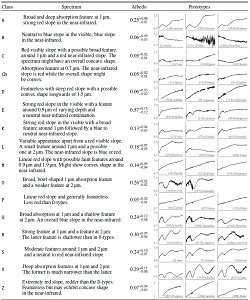Asteroid taxonomy from cluster analysis of spectrometry and albedo
- Details
- Published on 06 September 2022
Vol. 665
10. Planets and planetary systems
Asteroid taxonomy from cluster analysis of spectrometry and albedo

Asteroid taxonomy, the classification of asteroids according to their observational properties, has been developed over the last 40 years with the implicit assumption that asteroid spectral characteristics (albedo, spectral slope, band depth and shape, etc.) are related to surface mineralogy. Early classifications, based on a few objects, were limited to distinctions between broad classes, for example carbonaceous C types versus silicateous S types. They were followed by more detailed taxonomies, namely the Tholen and the Bus-DeMeo systems. The former focused on visible spectroscopy, including the albedo as a classification parameter, while the latter also encompassed the IR range but did not account for albedo; in both cases, the taxonomy was based on manually examining and classifying a few hundred asteroid spectra. Mahlke et al. here take advantage of the advent of large asteroid surveys and the development of modern classification techniques to propose a new asteroid taxonomy, which combines information from visible-near-IR spectroscopy and visible albedo values. From a methodological point of view, the novel aspects are: (i) the possibility to classify both partial and complete observations and (ii) the development of a probabilistic model for classification. The new taxonomy is based on almost 3000 observations of more than 2000 asteroids, an order of magnitude increase from that of DeMeo et al (2009), and more than 4500 asteroids are classified. While ensuring continuity with the previous classification schemes, it results in 17 classes split into the three complexes: C, S, and M. In particular, it features a new class, Z, for extremely red main-belt objects, and the reintroduction of visible albedo information resolves the degeneracy of the X complex in the Bus-DeMeo system. The new methodology is well suited for exploiting current and future asteroid data sets, among others the upcoming Gaia Data Release 3.


